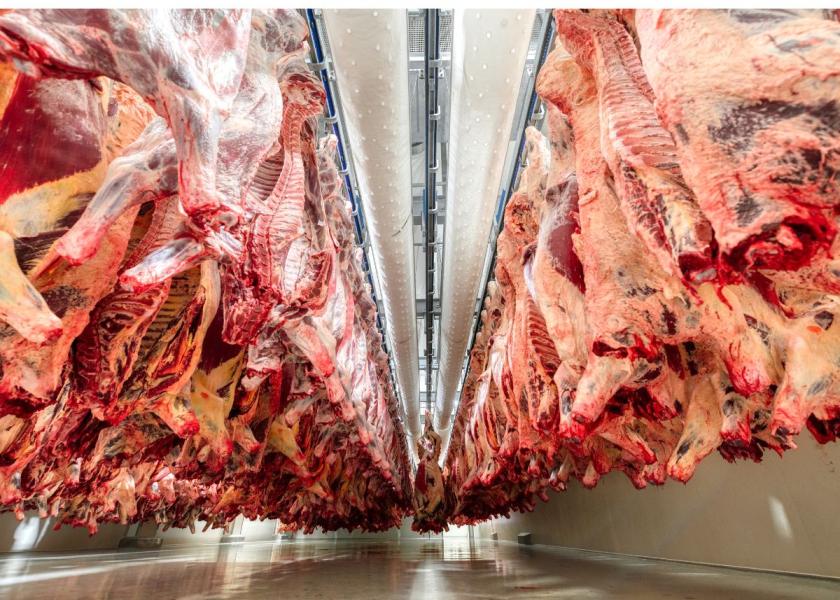Liver Abscesses in Beef-on-Dairy Cattle are Costing Packers Big Money

The beef-on-dairy phenomenon has seen explosive growth, especially as dairy producers look to diversify their operations and capitalize on high beef prices. However, no rose grows without a few thorns. And the thorn in the side of this new sector of the dairy industry has been the prolific amount of liver abscesses found in these crossbred cattle.
For dairy producers, this common health issue amongst beef-on-dairy animals does not necessarily have a big impact on their bottom line. But according to Dr. Blake Foraker, an assistant professor and meat scientist at Washington State University, this growing problem is costing packers two main things – time and money.
Time
“Liver abscesses are a big nuisance for packers because it really slows them down,” Foraker says. “In our beef-on-dairy population, we’re seeing liver abscess prevalence in 50% or more of animals. And this is holding up the production line.”
Carcasses with liver abscesses must have the organ removed manually by workers. Additionally, it must be inspected to see if the abscess has adhered to any other surrounding tissues. In turn, the extra time needed for the removal of tissue and further inspections adds up, slowing down the production line and potentially reducing the number of animals that can be processed through the facility each day.
“Time is of high importance to these packing plants,” Foraker says. “And liver abscesses, especially the severe cases, can cause a lot of rail-outs and cost packers a lot of additional time. So, this issue is something that they would really like to have resolved.”
Money
With the number of native beef animals in limited supply due to ongoing pressure with persistent drought, dairy farmers have been able to help keep meat cases full with the help of these beef-on-dairy cross animals. And while the meat from these cross animals is similar, and in some cases, more valuable than conventional beef, liver abscesses have been tainting one of the most valuable cuts of meat – the skirt steak.
“What will happen is a liver abscess will become so severe that the outside skirt muscle will adhere to the liver. In 2023, that skirt steak muscle was listed as the second most valuable cut of meat on a per-pound basis, coming in behind the tenderloin. So if packers have to cut this portion of meat out, then they are throwing away a high-dollar product,” Foraker says.
According to the beef-on-dairy specialist, dairy producers may only notice a small dock in price on the final hanging weight for their beef-on-dairy animal that had a liver abscess. However, the packers are seeing a much larger loss if additional meat needs to be trimmed.
“The outside skirt muscle, even though it only comprises about five pounds of a carcass, is worth around $12 a pound. If we have to remove that muscle because it's adhered to the liver because of a liver abscess, then that's about $60 per animal, which is rather significant,” Foraker says. “Now if you’re paid on a carcass weight basis, that's only $14 to you for losing five pounds because this trimming has to occur before the pay scale at the packing point. But if you're a packer, you've just lost $45 because there is now no longer an outside skirt steak from that carcass.”
According to Michigan State Extension Beef Specialist, Jerad Jaborek, livers condemned at slaughter represent an annual loss to the U.S. beef industry of more than $60 million. And that does not take into account the approximately 5-15% ding to average daily gain, and the 9.7% reduction in feed efficiency they also actuate.
“Packers are working to identify producers that are doing a good job at minimizing the prevalence of liver abscesses in their beef-on-dairy animals,” Foraker says. “Once those producers are identified, the packers are more likely to want to do business with them over a producer who is known to supply animals with this issue. So this liver abscess problem is something dairy producers certainly need to keep their eye on.”
For more on Beef-on-Dairy, read:
- Beef-on-Dairy Impacts the Overall Dairy Heifer Discussion
- Researchers Zero in on Liver Abscesses for Beef-on-Dairy
- Four Steps Veterinarians Can Take To Help Producers Transition To Beef-On-Dairy
- America's Heifer Shortage is Preventing Expansion. Is the Big Money for Beef-on-Dairy a Factor?
- Beef-on-Dairy: Why Feedlots Crave This Important Information
- How to Increase the Marketability of Beef-on-Dairy Calves







